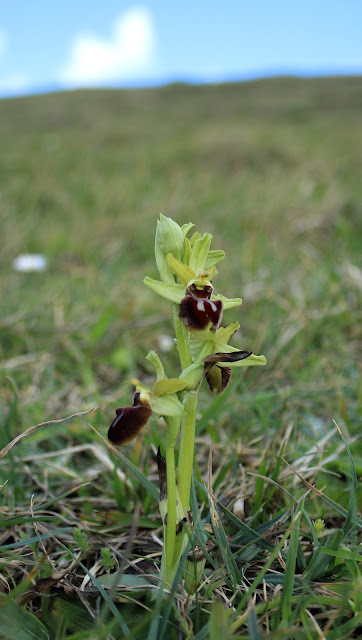Tuesday 16 April 2024
 |
| Early Spider Orchid Orchis sphegodes - Purbeck, Dorset |
The Early Spider Orchid, symbol of the Dorset Wildlife Trust (although they seem to favour the generic Wildlife Trust Badger these days), is one of the star plant species of Dorset's beautiful Purbeck coast - a chunk of limestone jutting out into the English Channel between Swanage and Weymouth. My destination today was Dancing Ledge, a popular spot where (with a bit of scrambling) you can reach a small swimming pond cut into a rocky ledge just above the waves.
 |
| Purbeck Cliffs at Dancing Ledge, Dorset (near orchid site) |
I should come clean - I had travelled to Dancing Ledge to look for Puffins, which are just about maintaining a breeding foothold in Dorset here. Typically, none were around. But the Early Spider Orchids more than compensated. They have a patchy distribution in the UK (see map from the National Biodiversity Network here), and are largely restricted to calcareous soils in Dorset, Sussex, Kent and the Brecks of East Anglia. In the UK, Early Spider Orchid is classed as 'nationally scarce', and is protected under the Wildlife and Countryside Act 1981. Fortunately, there were plenty around on the grassy slopes above Dancing Ledge: I saw at least a hundred spikes, many of which are right next to the steps that descend from Spyway Barn to meet the coast path. (If it was rarer, I wouldn't be doing a blog about it!) Nevertheless, I was careful to check that I wasn't flattening any when I took these photos. Late April is peak Early Spider Orchid viewing season down here; most will have gone over by late May.
 |
| Early Spider Orchid spike Orchis sphegodes - Purbeck, Dorset |
 |
| Bee Orchid Ophrys apifera - Powerstock Common Dorset (June 2015) |
There is also a Late Spider Orchid Ophrys fuciflora, which has a wider central lobe and pink (not green) tepals. As the name suggests, it flowers later than its early cousin (June to July). However, it is extremely rare in the UK, being restricted to east Kent. I have never seen one, but there are some nice images on a blog post by Martin Peacock (link here).


No comments:
Post a Comment